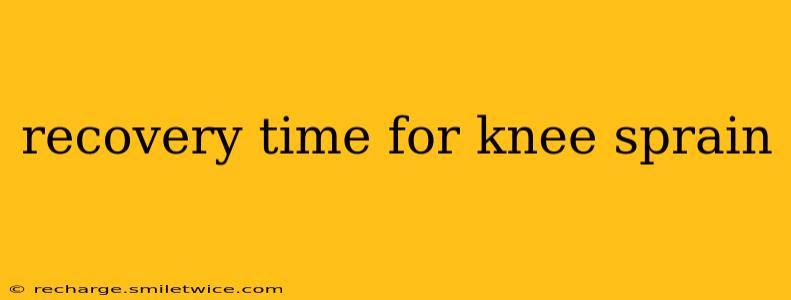A knee sprain, involving the stretching or tearing of ligaments around the knee joint, is a common injury affecting athletes and individuals alike. Recovery time significantly varies depending on the severity of the sprain, the individual's overall health, and the effectiveness of treatment. This guide will delve into the specifics of knee sprain recovery, addressing common questions and concerns.
What is the average recovery time for a knee sprain?
The average recovery time for a knee sprain ranges from a few weeks to several months. Minor sprains (Grade 1) might heal within a few weeks with rest and conservative treatment. Moderate sprains (Grade 2) typically require several weeks of rehabilitation, while severe sprains (Grade 3) may necessitate months of recovery, potentially including surgery.
How long does it take for a Grade 1 knee sprain to heal?
A Grade 1 knee sprain, characterized by mild stretching of the ligaments, usually heals within 2 to 3 weeks with proper care. This involves RICE (Rest, Ice, Compression, Elevation) therapy, over-the-counter pain relievers, and gentle range-of-motion exercises. Full recovery and return to normal activities usually occur within this timeframe.
How long does it take for a Grade 2 knee sprain to heal?
Grade 2 knee sprains, involving a partial tear of the ligaments, generally require 4 to 8 weeks for healing. Recovery involves more intensive physical therapy, focusing on strengthening and regaining stability in the knee. A longer recovery period might be necessary for individuals involved in high-impact activities.
How long does it take for a Grade 3 knee sprain to heal?
A Grade 3 knee sprain, indicating a complete tear of the ligament(s), often requires the longest recovery time, potentially ranging from several months to a year or more. Surgery might be necessary in severe cases to repair the damaged ligaments. Post-surgical rehabilitation is extensive and includes a rigorous program of physical therapy to restore function and stability.
What factors affect knee sprain recovery time?
Several factors influence the duration of knee sprain recovery:
- Severity of the sprain: Grade 1 sprains heal faster than Grade 2 or 3 sprains.
- Individual's age and overall health: Younger, healthier individuals tend to recover more quickly. Pre-existing conditions can also impact recovery time.
- Adherence to treatment: Following the prescribed treatment plan diligently is crucial for optimal healing.
- Type of ligament injured: Different ligaments within the knee have varying healing times.
- Presence of other injuries: Concurrent injuries, such as cartilage damage or meniscus tears, can prolong recovery.
What are the signs of a knee sprain healing properly?
Signs of proper healing include:
- Decreased pain and swelling: Pain and inflammation should gradually subside over time.
- Improved range of motion: You should be able to bend and straighten your knee without significant discomfort.
- Increased strength and stability: Your knee should feel stronger and more stable when performing activities.
- Return to normal activities: You should be able to gradually resume your normal activities without pain or instability.
When should I see a doctor for a knee sprain?
You should consult a doctor if:
- You experience significant pain, swelling, or instability in your knee.
- You hear a "pop" or feel a "give" in your knee at the time of injury.
- You are unable to bear weight on your leg.
- Your knee remains swollen or painful after a few days of home treatment.
- You experience numbness or tingling in your leg or foot.
This information is for general knowledge and does not substitute professional medical advice. Always consult with a healthcare professional for diagnosis and treatment of a knee sprain. They can provide a personalized assessment and recommend the most appropriate treatment plan based on your specific situation.
